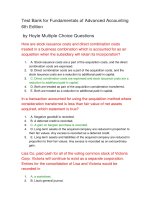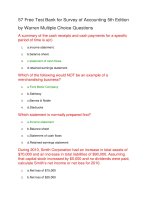Advanced accounting, 5th edition international student version ch13
Bạn đang xem bản rút gọn của tài liệu. Xem và tải ngay bản đầy đủ của tài liệu tại đây (465.51 KB, 37 trang )
13
13
Translation of Financial
Statements of Foreign Affiliates
Advanced Accounting, Fifth Edition
Slide
13-1
Learning
Learning Objectives
Objectives
1.
Distinguish between the current exchange rate and the
historical exchange rate.
2.
Understand the objectives of financial statement
translation.
3.
Identify the functional currency of a foreign entity.
4.
Compare the two methods used to convert the financial
statements of a foreign entity into U.S. dollars.
5.
Distinguish between the circumstances under which
each of the two methods is appropriate under current
GAAP.
Slide
13-2
Learning
Learning Objectives
Objectives
6.
Explain the factors involved in translating the
statements of a foreign entity operating in a highly
inflationary economy.
7.
Translate the statements of a foreign entity when the
functional currency is the local currency.
8.
Translate the statements of a foreign entity when the
functional currency is the U.S. dollar.
9.
Understand the concept of comprehensive income in
the context of foreign currency translation.
10.
Identify the disclosure requirements for firms with
foreign entities.
Slide
13-3
Translation
Translation of
of Financial
Financial Statements
Statements
A U.S. company may be involved in foreign
activities through the operations of a:
branch,
subsidiary, or
investee company.
Accounts of foreign activities, maintained in a foreign
currency, must be restated into U.S. dollars before
they are combined or consolidated or the equity
method of accounting applied.
Slide
13-4
Accounting
Accounting for
for Operations
Operations in
in Foreign
Foreign
Countries
Countries
A foreign subsidiary is consolidated if the parent
company owns, directly or indirectly, a controlling
interest in the voting stock of the subsidiary.
Exceptions include:
The intent to control is likely to be temporary.
Control does not actually rest with the parent
company.
Restriction on withdrawal of assets
Foreign statements
that
are not in conformity with GAAP in
Exchange
restrictions.
the United States must be adjusted to conform to U.S.
standards before conversion into U.S. dollars.
Slide
13-5
Translating
Translating Statements
Statements of
of Foreign
Foreign
Affiliates
Affiliates
The conversion from another currency into the currency of
the parent company is frequently called “translation.”
Translation Process
Financial
Statements in
Euros
Slide
13-6
Current
Exchange Rate
Historical
Exchange Rate
Financial
Statements in
U.S. Dollars
LO 1 Current versus historical exchange rates.
Translating
Translating Statements
Statements of
of Foreign
Foreign
Affiliates
Affiliates
Translation Adjustment or Translation Gain
or
TheLoss
difference between translating some accounts
using the current exchange rate and others using the
historical exchange rate.
Current standards require the translation adjustment
(gain or loss) be reported
Not a
currently in income or
Choic
e
deferred as a component of stockholders’ equity,
depending on the method used to translate the
accounts.
Slide
13-7
LO 1 Current versus historical exchange rates.
Objectives
Objectives of
of Translation
Translation
Functional Currency Concept
Objective of Translation – FASB ASC section 830-30:
1.
Provide information regarding the exposed economic
effects of an exchange rate change on an enterprise’s
cash flows and equity [par. 4(a)].
2.
Reflect in consolidated statements the financial results
measured in their functional currencies in conformity
with U.S. GAAP [par. 4(b)].
The Board believes that the operating performance and financial
condition of a foreign entity are best measured by expressing its accounts
in
the currency of the economic environment in which it primarily conducts
its operations and generates and expends its cash, its functional
currency.
Slide
13-8
LO 2 Objectives of translation.
Translation
Translation Methods
Methods
Current rate method
Slide
13-9
Translation
All assets and
liabilities.
Current exchange
rate.
Revenues and
expenses.
Exchange rate on
the date each
transaction
occurred.
LO 4 Two methods of conversion.
Translation
Translation Methods
Methods
Temporal Method
Monetary assets and
liabilities (cash, a/r, a/p).
Assets and liabilities carried
at historical cost.
Assets and liabilities carried
at current values.
Revenues and expenses
related to assets and
liabilities translated at
historical rates.
Translation
Current exchange
rate.
Historical exchange
rates.
Current exchange
rate.
Historical exchange
rates.
Other revenues and
expenses.
Slide
13-10
LO 4 Two
methods rate
of conversion.
Exchange
on
Identifying
Identifying the
the Functional
Functional Currency
Currency
The Functional Currency may be
1. The local currency of the foreign entity,
2. The U.S. dollar, or
3. The currency of a third country.
Economic Indicators of Functional Currency:
Slide
13-11
Cash flow
Expenses
Sales prices
Financing
Sales market
Intercompany
transactions
LO 3 Identifying the functional currency.
Identifying
Identifying the
the Functional
Functional Currency
Currency
Review Question
Indicators that the local currency is also the functional
currency include all of the following except:
a. The majority of the cash flows are in the local
currency.
b. Sales prices are determined by local market
conditions.
c. Financing is generally from the parent or
guaranteed by the parent.
d. Production costs and expenses are determined by
local conditions.
Slide
13-12
LO 3 Identifying the functional currency.
Translation
Translation of
of Foreign
Foreign Currency
Currency Financial
Financial
Statements
Statements
Remeasurement is the process of translating the
accounts of a foreign entity into its functional currency
when they are stated in another currency.
Translation. Accounts measured in the functional
currency are translated into the reporting currency
using the current rate method.
“Translation” may be used synonymously with the current
method, “remeasurement” is used synonymously with the
temporal method.
Slide
13-13
LO 4 Which methods of conversion to use.
Translation
Translation of
of Foreign
Foreign Currency
Currency Financial
Financial
Statements
Statements
Accounts stated in local currency of foreign
entity.
Is the foreign
economy
highly
inflationary?
Functional
currency (FC)
is U.S. Dollar.
No
No
Is the FC the
U.S. dollar?
Yes
Remeasure to
U.S. dollars
using temporal
method.
Slide
13-14
Determine the
functional currency (FC)
per
economic indicators.
Is the FC the
local currency?
No
Remeasure to
FC using
temporal
method.
Yes
Translate to
U.S. dollars
using current
rate method.
LO 4 Which methods of conversion to use.
Translation
Translation of
of Foreign
Foreign Currency
Currency Financial
Financial
Statements
Statements
Foreign Entity Operates in Highly Inflationary
Economy
It is the Board’s belief that the currency of a country
that has a highly inflationary economy has lost its
utility as a store of value and cannot be a functional
measuring unit.
This means the foreign financial statements should be
translated using the temporal method.
Slide
13-15
LO 6 Factors in a highly inflationary economy.
Translation
Translation of
of Foreign
Foreign Currency
Currency Financial
Financial
Statements
Statements
Foreign Entity in Economy that is Not Highly
Inflationary
Functional currency must be identified. Translation
process:
1. Local currency is the functional currency.
Current rate method.
Translation adjustment recorded as a component of
stockholders’ equity.
2. U.S. dollar is the functional currency.
Temporal method.
Slide
13-16
Translation adjustment reported in income
statement.
Translation
Translation of
of Foreign
Foreign Currency
Currency Financial
Financial
Statements
Statements
Books kept in
local currency
Local
currency
Remeasur
ement
Function
al
currency
Translati
on
U.S. dollar
Slide
13-17
Not
necessar
y
Temporal
method
Temporal
method
Local
currency
U.S.
dollar
A third
currency
Current
rate
method
Not
necessar
y
Current
rate
method
U. S. dollars
Translation
Translation –– Current
Current Rate
Rate Method
Method
Current exchange rate
Paid-in capital
Historical rate
Beginning R/E
Equals ending balance of last
year
Dividends
Revenue and Expenses
Cumulative translation
adjustment
Current year translation
adjustment
Slide
13-18
Translation
Current Rate
Method
Assets and
liabilities
Historical rate when dividend
is declared
Average exchange rate
Balance amount in the
balance sheet
Other comprehensive income
(shareholders’ equity)
LO 7 The functional currency is the local currency.
Translation
Translation –– Current
Current Rate
Rate Method
Method
Exercise 13-4: On January 1, 2008, Trenten Systems, a U.S.based company, purchased a controlling interest in Grant
Management Consultants located in Zurich, Switzerland.
Direct exchange rates for Swiss franc are:
Dollars per Franc
January 1, 2008
$.5987
December 31, 2008
.5321
Average for 2008
.5654
Dividend declaration and payment date
.5810
Required: Translate the year-end balance sheet and income
statement of the foreign subsidiary using the current rate
method of translation.
Slide
13-19
LO 7 The functional currency is the local currency.
Translation
Translation –– Current
Current Rate
Rate Method
Method
Exercise 13-4: (Current Rate
Method)
Slide
13-20
Translation
Translation –– Current
Current Rate
Rate Method
Method
Exercise 13-4: Prepare a schedule to verify the
translation adjustment.
Swiss
Francs
Exposed net asset position - 1/1
Translation
Rate
$
30,000
$.5987
17,961
45,000
.5654
25,443
Adjustment for changes in net asset position:
Net income
Dividends
(15,000)
Net asset position translated
Exposed net asset position - 12/31
Cumulative translation adjustment (debit)
Slide
13-21
.5810
--60,000
(8,715)
34,689
.5321
31,926
(2,763)
LO 7 The functional currency is the local currency.
Translation
Translation –– Current
Current Rate
Rate Method
Method
Review Question
Under the current method of currency translation,
which of the following balance sheet accounts is
translated at historical exchange rates?
a. Cash
b. Accounts Receivable
c. Bonds Payable
d. Common Stock
Slide
13-22
LO 7 The functional currency is the local currency.
Translation
Translation –– Temporal
Temporal Method
Method
Temporal Method
Monetary assets and
liabilities (cash, a/r, a/p).
Assets and liabilities carried
at historical cost.
Assets and liabilities carried
at current values.
Revenues and expenses
related to assets and
liabilities translated at
historical rates.
Translation
Current exchange
rate.
Historical exchange
rates.
Current exchange
rate.
Historical exchange
rates.
Other revenues and
expenses.
Slide
13-23
LO 8 The functional currency
is the
Exchange
rateU.S.
on dollar.
Translation
Translation –– Temporal
Temporal Method
Method
Exercise 13-5: On January 1, 2008, Trenten Systems, a U.S.based company, purchased a controlling interest in Grant
Management Consultants located in Zurich, Switzerland.
Direct exchange rates for Swiss franc are:
Dollars per Franc
January 1, 2008
$.5987
December 31, 2008
.5321
Average for 2008
.5654
Dividend declaration and payment date
.5810
Required: Convert (remeasure) the financial statements of
the foreign subsidiary using the temporal method of
translation.
Slide
13-24
LO 7 The functional currency is the local currency.
Translation
Translation –– Temporal
Temporal Method
Method
Exercise 13-5: (Temporal Method)
Income Statement
Revenue
Operating expenses: depreciation
Operating expenses: other
Translation loss
Net income
Retained earnings 1/1
Dividends
Retained earnings 12/31
Slide
13-25
Swiss
Francs
75,000
(3,000)
(27,000)
45,000
10,000
55,000
(15,000)
40,000
Translation
Rate
0.5654
0.5987
0.5654
0.5987
0.5810
U.S. Dollars
42,405
(1,796)
(15,266)
(198)
25,145
5,987
31,132
(8,715)
22,417
Balance Sheet
Cash and receivables
Net property, plant, equipment
Total assets
55,000
37,000
92,000
0.5321
0.5987
29,266
22,152
51,418
Accounts payable
Common stock
Retained earnings
Total liab. & equity
32,000
20,000
40,000
92,000
0.5321
0.5987
17,027
11,974
22,417
51,418









